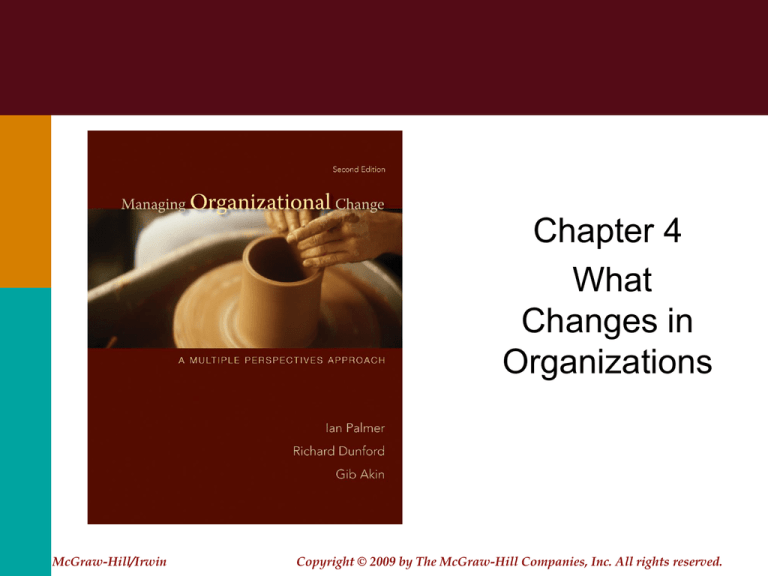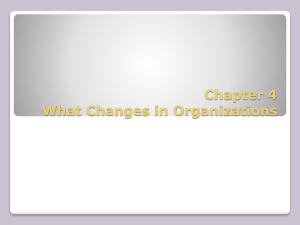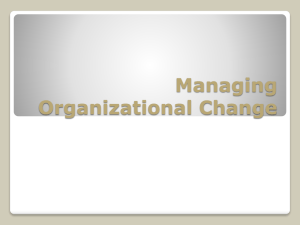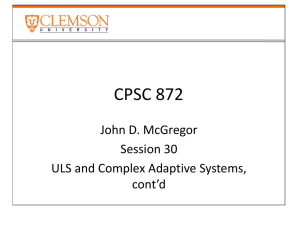
Chapter 4
What
Changes in
Organizations
McGraw-Hill/Irwin
Copyright © 2009 by The McGraw-Hill Companies, Inc. All rights reserved.
Scale of Change
Scale of
Change:
-1st order
-2nd order
Between 1st &
2nd Order
Change
Implications for
Change
Managers
Types of
Change:
-Downsizing
-Technological
-Mergers
-Key Change
Challenges
• First-order change:
– Incremental
– Maintains and develops the organization
– E.g. continuous and smaller changes to
the structure of an organisation
• Second-order change:
– Transformational
– Fundamentally changes the way an
organization functions
– E.g. downsizing
4-2
Between 1st & 2nd Order Change
Scale of
Change:
-1st order
-2nd order
Between 1st &
2nd Order
Change
Implications for
Change
Managers
Types of
Change:
-Downsizing
-Technological
-Mergers
-Key Change
Challenges
• Mid-range changes
– Overcomes inertia but is not revolutionary
– Avoids the alarming implications of large
scale change
• Punctuated equilibrium
– Long periods of stability followed by short
bursts of change and instability
• Robust transformation
– Considers environmental conditions as
being temporary and requiring robust
responses including the enactment of
new capabilities.
4-3
Implications for Change Managers
Scale of
Change:
-1st order
-2nd order
Between 1st &
2nd Order
Change
Implications for
Change
Managers
Types of
Change:
-Downsizing
-Technological
-Mergers
-Key Change
Challenges
Implication for Change
Manager
Image of Managing Change
Care needs to be taken in assuming that types
of organizational changes can be neatly
categorized as small, adaptive, and incremental
compared to those that are large and
transformational.
Interpreter: The change manager as interpreter image
reminds us that whether a change is adaptive, reactive,
or transforming will depend upon the perspective of the
person doing the considering
Multiple types of changes simultaneously
should also be considered. In addition, some
changes require other changes nested under
them in order for another change to proceed.
Navigator: when implementing multiple changes, there
is likely to be contact with different groups that will
require negotiation and navigation through a range of
issues—not all of which they will be able to control.
From chaos theory we know that small
changes, at an individual level, may have larger,
unanticipated consequences throughout the
organization
Nurturer: Change managers can nurture and shape
people’s perceptions and reactions to change but not
control them.
There are a number of inertial forces that act as
a drag on individuals and organizations in
adopting adaptive, first-order change.
Coach: the managers of change are likely to assume
that, as long as people have been well “coached” in a
variety of organizational skills, then, when organizational
“problems” are triggered, they will take the initiative and
make appropriate adaptive changes to alter
organizational practices and routines.
Change managers need to remember what
might appear at first sight to be a paradox, that
often change is needed in order to remain
stable.
Director: Change managers who adopt a directing
image of change also need to remember that they will
need to provide directions about stability: telling people
what will not be changing, or what will remain the same.
4-4
Implications for Change Managers
Scale of
Change:
-1st order
-2nd order
Between 1st &
2nd Order
Change
Implications for
Change
Managers
Types of
Change:
-Downsizing
-Technological
-Mergers
-Key Change
Challenges
Implication for Change
Manager
Image of Managing Change
Change may mean adding on
to, and integrating, rather than
removing and replacing
current practices.
What this reminds the managers of
change is that they need to assess
how carrying out a change will
impact upon current practices
There is often an implicit
assumption that incremental,
adaptive changes are less
risky than large, second-order
transformational changes.
For the manager of change, this
requires both assessing the scale
of change (incremental/radical)
from the perspective of the affected
parties as well as assessing the
risk involved (of changing rather
than staying the same) and the
different ways in which risk can be
ameliorated.
4-5
Types of Change
Scale of
Change:
-1st order
-2nd order
Between 1st &
2nd Order
Change
Implications for
Change
Managers
Types of
Change:
-Downsizing
-Technological
-Mergers
-Key Change
Challenges
DOWNSIZING
• Approaches to downsizing:
– Retrenchment
– Downscaling
– Downscoping
• Does not necessarily lead to
increased productivity
• Can be an excessively costly
exercise
4-6
Types of Change
Scale of
Change:
-1st order
-2nd order
Between 1st &
2nd Order
Change
Implications for
Change
Managers
Types of
Change:
-Downsizing
-Technological
-Mergers
-Key Change
Challenges
TECHNOLOGICAL CHANGE
• There are a variety of new
technologies being used, for example:
– Customer relationship management
(CRM) systems
– Enterprise resource planning (ERP)
– Wireless technology
– Business process reengineering (BPR)
– Six Sigma
4-7
Types of Change
Scale of
Change:
-1st order
-2nd order
Between 1st &
2nd Order
Change
Implications for
Change
Managers
Types of
Change:
-Downsizing
-Technological
-Mergers
-Key Change
Challenges
MERGERS AND ACQUISITIONS
• Enable organizational growth at
an accelerated rate
• Types of mergers and
acquisitions:
– Excessive capacity
– Neighboring market expansion
– New product or market investment
– Research and development
– Leveraging to create industries
4-8
Key Change Challenges
Scale of
Change:
-1st order
-2nd order
Between 1st &
2nd Order
Change
Implications for
Change
Managers
Types of
Change:
-Downsizing
-Technological
-Mergers
-Key Change
Challenges
This table outlines the key change challenges
for the three types of change. These issues
need to be addressed when managing change
Downsizing
New Technologies
Mergers &
Acquisitions
Employee retention.
Goal synthesis.
Cost savings.
Avoiding “hard
landings”.
Choice of technology
Cultural adjustment.
Minimizing political
behavior and loss of
teamwork.
Identifying political
barriers.
Balancing change and
continuity.
Survivor syndrome
The IT team.
Due diligence.
Communication
Communication
Employee retention
Due diligence
Time frame.
Contingency planning.
Cultural adjustment.
Contingency planning
Power structure.
Choice of restructuring
technique
Communication
4-9








